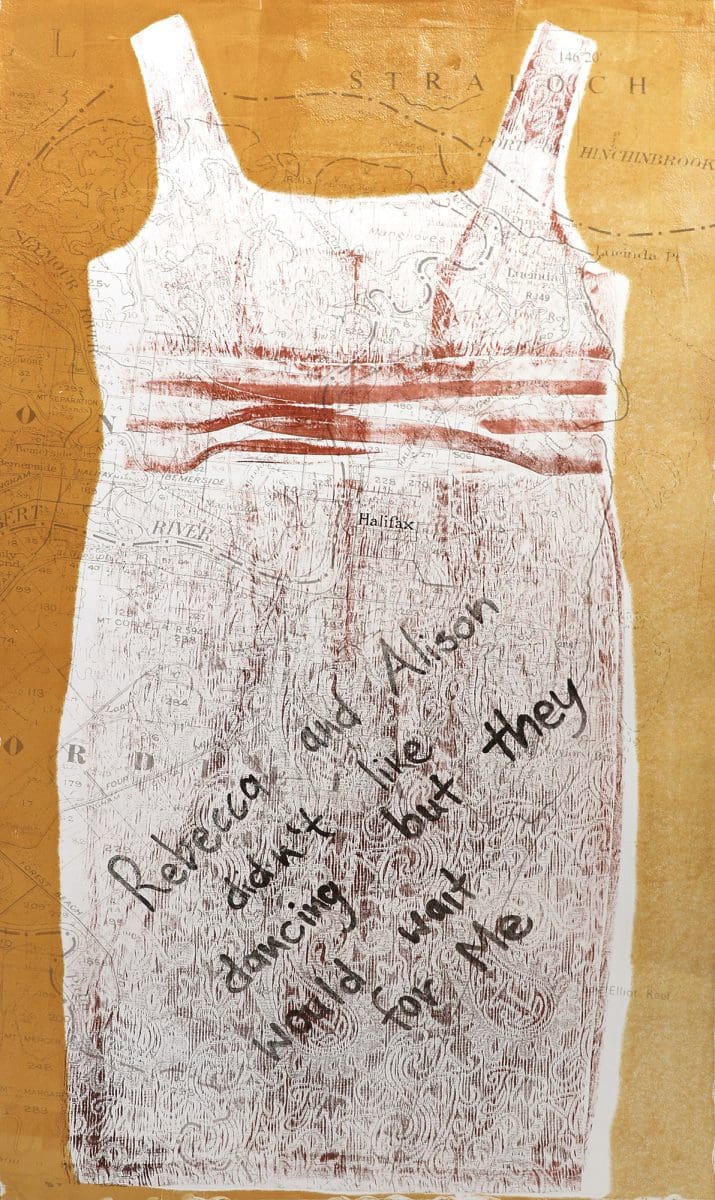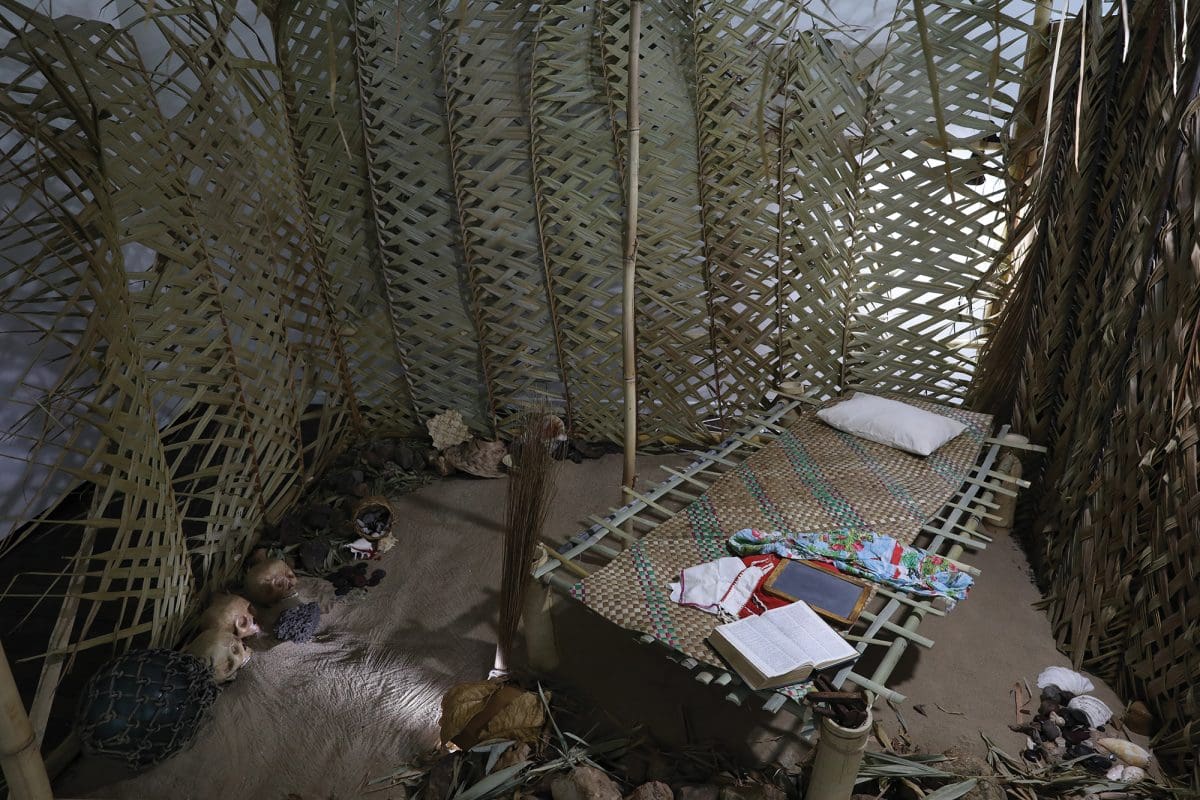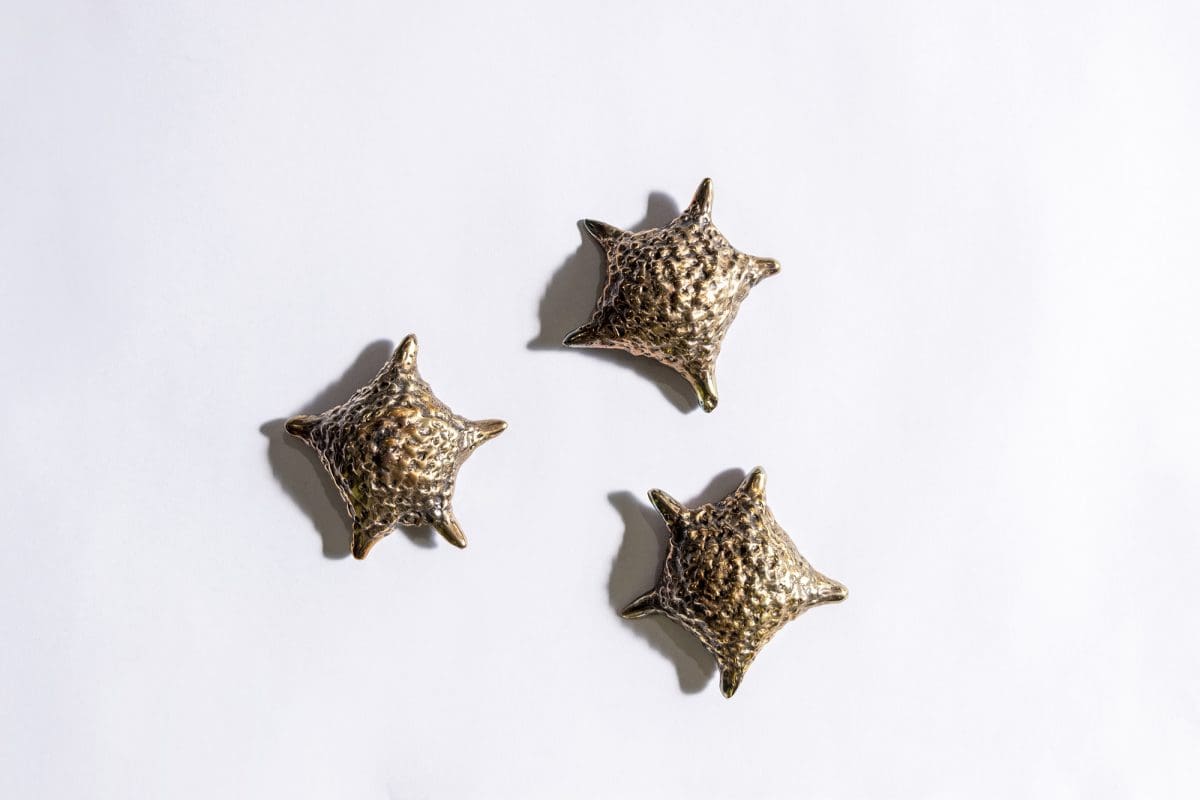
Piercing the veil
A new exhibition at Buxton Contemporary finds a rich complexity in the shadowy terrain between life and death.

Gail Mabo; featured in Tarnanthi 2021, Art Gallery of South Australia, Adelaide; Photograph: Sia Duff.

Gail Mabo, Party Dress 1, 2021, Monoprint on paper, 112 x 76cm (paper); 111 x 64cm (print); printed by Ron McBurnie of Monsoon Publishing, Townsville; featured in Gail Mabo – House of Cards. House of Cards is an Umbrella Studio Contemporary Arts exhibition.

Gail Mabo, Dad’s Childhood Akur Meta (installation detail); featured in Gail Mabo – House of Cards; Photograph: Kate O’Hara. House of Cards is an Umbrella Studio Contemporary Arts exhibition.

Gail Mabo, My Childhood Home (installation detail from above); featured in Gail Mabo – House of Cards; Photograph: Kate O’Hara. House of Cards is an Umbrella Studio Contemporary Arts exhibition.

Gail Mabo, Wer (Star), 2022, Cast bronze with tortoise shell patina, limited edition, dimensions variable on installation; image courtesy of Urban Art Projects.
Eddie Mabo used to hide a shotgun above the manhole in the ceiling of his family’s home. It was the late 1970s and there had been ASIO surveillance of the house, threatening phone calls, and other safety concerns. Protecting his family was uppermost in the mind of Mabo (1936-92), the Torres Strait Islands man who later became the famed land rights activist central to the High Court’s landmark 1992 decision to overturn the legal doctrine of “terra nullius”.
His daughter Gail, one of seven children, well remembers the gun and what it symbolised, but she processes the experiences of her childhood years through the prism of creativity. A Townsville-based artist experienced with many modes of making—she started out in dance, but now has installation, sculpture, printmaking, painting and other skills in her extensive practice—Mabo has enjoyed great success in recent years.
She was commissioned by the Art Gallery of New South Wales and by the Art Gallery of South Australia’s Tarnanthi Festival to make major new works, which entered their collections, and she was a finalist in the 2022 Telstra National Aboriginal and Torres Strait Islander Art Awards (NATSIAA), Australia’s richest Indigenous art prize.
Now, she is now preparing for 2023 shows at McClelland Sculpture Park and Gallery and at Monash University Museum of Art, while her exhibition House of Cards remains on show in Rockhampton Museum of Art (RMOA) to engage visitors with stories of her childhood, and those of her parents. “It is a living memory of what my parents told me,” she says of House of Cards. “These are the connections to space, made through the memories we forge, through the things we did. It is how the stories told around the kitchen table—about dad growing up and mum growing up—came to life.”

Mabo says this show emerged from a “knee jerk reaction” when she was displaced from the family home, where she had continued to live in adulthood, as a result of a divorce-related court order. She had started living in that house when she was six month sold in 1965. “But the house lives within me, the memories cannot be taken away,” Mabo says. “I said to my son, if I had a pack of blank playing cards, I could write52 memories of me growing up in that house with my mum and dad and my siblings.”
That is what she did: in the installation, a version of a part of that family home is wedged between representations of her mother’s and father’s childhood dwellings. On the walls she has hand-written a collection of memories, reminiscent of the way “a naughty child will do writing on the wall to get something out”. In the exposed ceiling of this part of the installation, a shotgun rests on the rafters.
It’s a work bound to memories of her father, and surveillance. “He’d get a call and the person would say, ‘We know where you live, do you know where your[seven] children are?’ He’d line us up and count us—one, two, three, four, five, six—I was the one who was missing. I was the athlete, down the road running around the oval because I wanted to represent the State, go down to Brisbane.”
She’d get in trouble with her dad for not being there. “It was only through fear that he did that. He would say, ‘My girl, you know I got that phone call again and I was scared for you.’ My tunnel vision was on running. Only now I realise how much pressure he was under, not just being the activist, but because he was part of the Communist Party and they were being watched.”
While a related exhibition, Legacy: Reflections on Mabo, is also showing at RMOA, the three domestic settings in House of Cards manifest as both representational and dreamlike environments. Mabo’s mother, Dr Bonita Mabo, had lived in a place with tin walls and a dirt floor—it was her “happy place,” says her daughter—while her father spent his early years in a Mer island akur meta (house) made from bamboo. These two recreated spaces draw on the memories shared by Mabo’s parents and contain objects passed down to her, along with items specially made by her for the show. “It is all from memory,” she says.
Some things reflect a child’s over-active imagination: for example, the hole in the tin walls alongside where her mother and siblings used to sleep is larger than it probably was. Other aspects present Indigenous knowledge: the rocks on the floor covered in leaves around the perimeter of her father’s childhood hut indicate the local lore of boundaries where outsiders (the audience) cannot touch what is not theirs.
“Building something, constructing—that is me,” Mabo says. “I’ll have a go—as an artist, I can step into that realm and have fun doing it. It is all about digging deeper into those memories and how I can portray it for people to see… to evoke a conversation. A lot of people connect to it, coming through and talking about their own memories [of a childhood house].”
House of Cards
Gail Mabo
Rockhampton Museum of Art
Until 19 February
This article was originally published in the January/February 2023 print edition of Art Guide Australia.